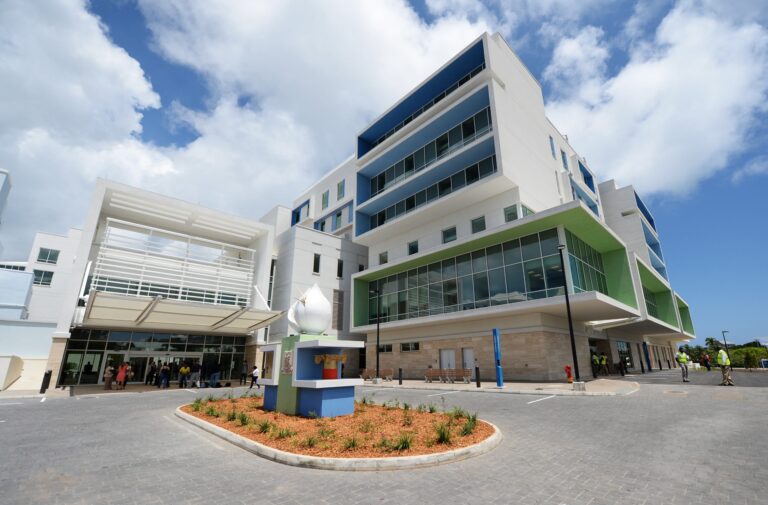Once a storm hits, it’s time to lay low, stay home and keep off the roads until they are safe and cleared. But, what if you fall ill during this time? What happens if you go into labour or have an accident? The hospital has to be prepared for all eventualities and to help them — and so should we.
“People must be prepared at home with enough medication, food and water to see them through the storm and its aftermath,” said Anna Nowak, vice-president, public relations, at the Bermuda Hospitals Board. “People with diabetes will need their medication and food, many others may just need adequate medical supplies.” Everyone, she emphasised, should have an up-to-date first aid kit.
She also warned against taking any risks during a storm: “Be careful on ladders as you prepare ahead of time, be careful if there is broken glass from a blown-in window, and especially, after the storm, keep away from downed power lines.” She also urged caution if using machetes or saws to clear up after a storm.
One risk many Bermuda residents do tend to take is going outside for some fresh air if the eye passes over the island: “The winds can pick up incredibly fast on the other side, so it can be dangerous,” she said.
These warnings are important because, should an emergency occur, an ambulance may not be able to get to you: “If the emergency is outside and requires a response, such as an ambulance, we will review what the weather is at that time,” explained Ms Nowak. “If it is at a particularly bad time for winds, storm surge or rain, we can’t risk the lives of our staff, but, if there is enough of a break in the wind intensity, we may be able to send out an ambulance.
“It is not just the weather they have to contend with, but downed trees and powerlines, which can be very dangerous.”
They will, however, do everything they can and on one occasion, they were able to work with the police to open the Causeway when a life-threatening situation meant a patient needed to get across.
While there is always the risk of a situation that can’t be planned for, BHB tries to prepare for as much as is possible at all their locations, and the hospital is a busy place to be during a hurricane.
In addition to inpatients and long-term care residents, pregnant women who are close to term or may have a high-risk pregnancy are advised to come into the hospital for the duration of the storm. “We’ve had more than 20 pregnant women in before,” said Ms Nowak.
People requiring oxygen, she added, do not need to come in because “they do not need medical care, but just a continuous supply of electricity and oxygen.” If they are unable to get this at home, they can go to the government shelter at CedarBridge Academy, where there is also a nurse.
Once they know a hurricane is going to hit, the BHB’s hurricane response plan moves from monitoring and checking, into action, and their priority is to ensure that they “can continue to care for all our inpatients, our long-term care residents who may be on the MWI or KEMH campus or in a group home, and that inpatient, emergency care and maternity services are continuous,” she explained.
This includes having two shifts of staff at the two main hospital sites for the duration of the storm.
“For major hurricanes we will go into what is called ‘lockdown’,” said Ms Nowak. “The start is when everyone we need to get through the storm are on-site. It is only lifted when it is safe enough for relief staff to get in. We can be in lockdown for over 30 hours in a big storm. Shifts on clinical inpatient units will usually last 12 hours, so the second shift of staff take over while the first shift sleep.”
There will also be staff to cover all clinical and support areas should there be a medical or mental health crisis either within, or outside, the hospital. This includes nurses, doctors, surgeons, anaesthetists, obstetricians, laboratory and imaging services, and pharmacy staff. There is also IT support, dietary staff to cook and deliver patient meals, public relations and administrative staff.
In addition to this, the Lamb Foggo Urgent Care Centre is open throughout the storm to ensure St George’s and St David’s are not cut off from medical care while the causeway is closed.
The “biggest heroes”, however said Ms Nowak, are the support staff, in particular facilities and environmental services who are the “emergency staff” for the building. “During Hurricane Nicole, we had a lot of water ingress, including quite dramatically down an elevator shaft and through the front doors of the general wing lobby. The leaks need to be managed and cleaned up by these teams and the activity can be intense if it’s a bad storm with a lot of rain.”
The biggest patient challenge they have had to deal with in recent times was in October 2014, when they had to evacuate over 100 patients out of the old, now-demolished, continuing care building during the height of Hurricane Gonzalo.
“Off-shift staff came to help as one by one, patients, many of whom were in wheelchairs, were assisted out of the unit,” she said.
Working in the hospital during a hurricane is tough, but Ms Nowak praised the lengths to which everyone goes to support each other.
“Being away from home and family is hard, especially as power goes out and you lose contact with your loved ones,” she said. “It is also very hard work. Staff are sleeping wherever they can find space, and everyone is working long hours to get through. Having said that, we all pull together. There is a feeling of family at these times as we do all we can to keep caring for our community.”

